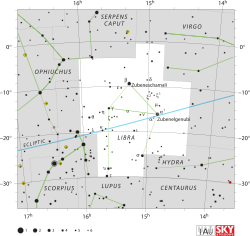천칭자리 베타
Beta Librae| 관찰 데이터 Epoch J2000 Equinox J2000 | |
|---|---|
| 콘스텔레이션 | 천칭자리 |
| 적경 | 15h 17m 00.41382s[1] |
| 적위 | - 09° 22° 58.4919°[1] |
| 겉보기 등급(V) | 2.61[2] |
| 특성. | |
| 스펙트럼형 | B8 V[3] |
| U-B 색지수 | - 0.359[4] |
| B-V 색지수 | -0.124[4] |
| 변수 유형 | 의심스럽다 |
| 아스트로메트리 | |
| 반지름 속도(Rv) | - 35.2 km[2]/s |
| 고유운동(μ) | RA: - 98.10[1] mas/년 Dec.: - 19.65[1] mas/년 |
| 시차()) | 17.62 ± 0.16 mas[1] |
| 거리 | 185 ± 2 리 (56.8 ± 0.5 pc) |
| 절대 등급(MV) | - 1.16[5] |
| 세부 사항 | |
| 덩어리 | 3.5+0.3 −0.2[3] M☉ |
| 반지름 | 4.9[6] R☉ |
| 광도 | 130 L☉ |
| 온도 | 12300[7] K |
| 금속성 [Fe/H] | 0.33덱스[3] |
| 회전 속도(v sin i) | 250[8] km/s |
| 나이 | 80+50 −40[3] 미르 |
| 기타 명칭 | |
| 데이터베이스 참조 | |
| 심바디 | 데이터. |
천칭자리 베타(β Librae, 약칭 Beta Lib, β Lib)는 공식적으로 Zubeneschamali /zuːbɛnɛmelili/[10][11]로 명명된 천칭자리 베타에서 가장 밝은 별이다.시차 측정에서 이 별의 거리는 [1]태양으로부터 185광년(57파섹)으로 추정할 수 있다.
이 별의 겉보기 등급은 2.[2]6입니다.에라토스테네스에 따르면 천칭자리 베타는 안타레스보다 밝은 것으로 관측되었다.350년 후, 프톨레마이오스는 그것이 안타레스만큼 밝다고 말했다.이 차이는 안타레스가 밝아졌기 때문일 수 있지만, 이것은 확실히 알려져 있지 않다.단순히 천칭자리 베타가 변광성이기 때문에 생겨난 것일 수 있으며,[12] 이는 현재 0.03 등급의 변동성을 보여준다.
이름.
천칭자리 β(라틴어: Librae Beta Librae)는 이 별의 바이어 명칭이다.
그것은 전통적인 이름인 Zubeneschamali /zubbənˌmelili/ (덜 흔하지 않은 렌더링, 즉 부패는 Zuben Escamali, Zubenel Chamali, Zubenesch, Zubenelg)를 가지고 있으며, 아랍어 ا the the the the the the the the the the the the the the the the the the the the the the the the the the the the the the the the the the the the the the the the the the the the the the the the the the the the the the the the the the the the the the the the the the the the the the the the the the이 이름은 천칭자리가 "전갈의 발톱"[12]을 나타내는 것으로 여겨졌던 시기에 유래되었다.아랍어 알-키파 아시-샤말리예의 "북쪽 팬"과 라틴어 동급의 란스 [13]보렐리스도 있었다.2016년 국제천문연맹은 별의 고유 명칭을 목록화하고 표준화하기 위해 별명 작업반(WGSN)[14]을 조직했다.WGSN은 2016년 8월 21일 이 별의 이름을 주베네스차말리로 승인했으며 현재 IAU 항성명칭 목록에 [11]등재되어 있다.
중국어로 루트(root)를 뜻하는 liù(D), Xi li)는 β 천칭, α2 천칭, li 천칭,[15] li 천칭으로 이루어진 별자리를 말한다.따라서 β Librae의 중국어 이름 자체는 "뿌리의 [16]네 번째 별"인 D li Xi s si이다.
특성.
천칭자리 베타는 스펙트럼의 특징으로 볼 때 B8 [3]V의 항성 분류를 가지고 있어 B형 주계열성이 된다.태양보다 약 130배 더 밝으며 표면 온도는 태양의 두 배인 12,300 K이다.[7]이 고온은 단순한 스펙트럼으로 빛을 만들어내기 때문에 지구와 별 사이의 성간 가스와 먼지를 조사하는데 이상적입니다.다른 별들과 마찬가지로 태양보다 100배 이상 빠른 속도로 공전하고 있으며, 자전−1 속도는 250km/[8]s로 예측된다.주성의 측정된 각지름은 0.801 [7]mas이다.이 계의 추정 거리에서는 태양의 [6]반지름의 약 4.9배의 물리적 크기를 산출합니다.
이런 종류의 거대하고 수소를 융합하는 별은 종종 청백색으로 보이며, 현대 관측자들에 의해 보통 흰색 또는 청록색으로 언급되지만, 이전의 관측자들은 리브라에 베타를 육안으로 [17]볼 수 있는 유일한 녹색 별이라고 종종 묘사했다.일부 관측자들이 왜 그것을 [18]녹색으로 보는지에 대해 일반적으로 받아들여지는 설명은 없는 것 같다.천칭자리 베타 등급의 작은 주기적 변화는 지구에서 [19]직접 관측할 수 없는 동반성의 존재를 암시합니다.그러나 그것은 단일 별로 [20]분류된다.
「 」를 참조해 주세요.
- 천칭자리의 항성 목록
- 알파 리브라에 (Zubenelgenubi
레퍼런스
- ^ a b c d e f van Leeuwen, F. (November 2007). "Validation of the new Hipparcos reduction". Astronomy and Astrophysics. 474 (2): 653–664. arXiv:0708.1752. Bibcode:2007A&A...474..653V. doi:10.1051/0004-6361:20078357. S2CID 18759600.
- ^ a b c Wielen, R.; et al. (1999), "Sixth Catalogue of Fundamental Stars (FK6). Part I. Basic fundamental stars with direct solutions", Veröff. Astron. Rechen-Inst. Heidelb, Astronomisches Rechen-Institut Heidelberg, 35 (35): 1, Bibcode:1999VeARI..35....1W.
- ^ a b c d e Janson, Markus; et al. (August 2011), "High-contrast Imaging Search for Planets and Brown Dwarfs around the Most Massive Stars in the Solar Neighborhood", The Astrophysical Journal, 736 (2): 89, arXiv:1105.2577, Bibcode:2011ApJ...736...89J, doi:10.1088/0004-637X/736/2/89, S2CID 119217803
- ^ a b Gutierrez-Moreno, Adelina; Moreno, Hugo (June 1968), "A photometric investigation of the Scorpio-Centaurus association", Astrophysical Journal Supplement, 15: 459, Bibcode:1968ApJS...15..459G, doi:10.1086/190168
- ^ Anderson, E.; Francis, Ch. (2012), "XHIP: An extended hipparcos compilation", Astronomy Letters, 38 (5): 331, arXiv:1108.4971, Bibcode:2012AstL...38..331A, doi:10.1134/S1063773712050015, S2CID 119257644.
- ^ a b 반지름(R*)은 다음과 같이 구한다Lang, Kenneth R. (2006), Astrophysical formulae, Astronomy and astrophysics library, vol. 1 (3 ed.), Birkhäuser, ISBN 3540296921.
- ^ a b c Zorec, J.; et al. (July 2009), "Fundamental parameters of B supergiants from the BCD system. I. Calibration of the (λ_1, D) parameters into Teff", Astronomy and Astrophysics, 501 (1): 297–320, arXiv:0903.5134, Bibcode:2009A&A...501..297Z, doi:10.1051/0004-6361/200811147, S2CID 14969137
- ^ a b Abt, Helmut A.; Levato, Hugo; Grosso, Monica (July 2002), "Rotational Velocities of B Stars", The Astrophysical Journal, 573 (1): 359–365, Bibcode:2002ApJ...573..359A, doi:10.1086/340590
- ^ "bet Lib". SIMBAD. Centre de données astronomiques de Strasbourg. Retrieved 2007-01-22.
- ^ Kunitzsch, Paul; Smart, Tim (2006). A Dictionary of Modern star Names: A Short Guide to 254 Star Names and Their Derivations (2nd rev. ed.). Cambridge, Massachusetts: Sky Pub. ISBN 978-1-931559-44-7.
- ^ a b "IAU Catalog of Star Names". Retrieved 28 July 2016.
- ^ a b AAS (2006), "LIBRA – A Balanced View (page 7 of PDF)" (PDF), Auckland Astronomical Society, retrieved 2009-01-25
- ^ 13페이지의 별표 참조La Hire, Philippe (1727), Tabulae Astronomicae, Parisiis : Apud Montalant, typographum & bibliopolam ....
- ^ IAU Working Group on Star Names (WGSN), International Astronomical Union, retrieved 22 May 2016.
- ^ (in Chinese) 中國星座神話, written by 陳久金.2005년 발행, ISBN 978-986-7332-25-7.
- ^ 2008-10-25 홍콩 우주 박물관 웨이백 머신에서 보관.2010년 11월 23일 회선으로 액세스.
- ^ Kaler, James B. (2006), "Zubeneschamali", Stars, University of Illinois, archived from the original on 2006-07-14, retrieved 2006-07-03
- ^ Burnham, Robert, Jr. (1978), Burnham's Celestial Handbook, vol. 2, New York: Dover Publications, p. 1105, ISBN 0-486-23568-8.
- ^ Mark Fisher (1999–2006), "Zuben Elschemali", The Electronic Sky, retrieved 2009-01-25
- ^ Eggleton, P. P.; Tokovinin, A. A. (September 2008). "A catalogue of multiplicity among bright stellar systems". Monthly Notices of the Royal Astronomical Society. 389 (2): 869–879. arXiv:0806.2878. Bibcode:2008MNRAS.389..869E. doi:10.1111/j.1365-2966.2008.13596.x. S2CID 14878976.




